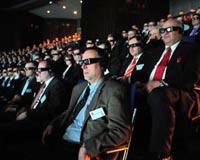| . |  |
. |
Edwards AFB CA (SPX) Oct 18, 2010 Northrop Grumman has begun flight testing the new computing hardware and communications infrastructure that will eventually allow the B-2 stealth bomber to send and receive battlefield information by satellite more than 100 times faster than today. Since Sept. 1, the company has conducted a series of test flights using a B-2 test aircraft stationed at Edwards Air Force Base, Calif. The flight test program is part of Increment 1 of the U.S. Air Force's B-2 extremely high frequency (EHF) satellite communications program. Northrop Grumman is the Air Force's prime contractor for the B-2 Spirit, the flagship of the nation's long range strike arsenal, and one of the world's most survivable aircraft systems. The B-2 is the only combat-proven stealth platform in the current U.S. inventory. "The flight test program has demonstrated that the EHF Increment 1 computer upgrade system has reached a maturity level that allows us to conduct test sorties beyond the Edwards AFB local area with confidence," said Ron Naylor, Northrop Grumman's director of the EHF Increment 1 development program. "It also adds momentum to our efforts to give the B-2 the high speed data handling infrastructure it will need for critical communications and weapons delivery upgrades in the future." Naylor attributes the success of the test flight program, in part, to the Northrop Grumman ground crews that helped perform the pre-flight checkout and maintenance on the B-2 test aircraft. "Collaborating with the Air Force will allow us to increase the tempo and frequency of B-2 sorties from Edwards," explains Naylor, "which will also help the company speed the rate at which new capabilities for the B-2 can be made available for the warfighter." The EHF Increment 1 system that flew includes: + A new integrated processing unit developed by Lockheed Martin Systems Integration, Owego, NY., that will replace up to a dozen current stand-alone avionics computers on the B-2; + A new disk drive unit developed by Honeywell Defense and Space Electronic Systems, Plymouth, Minn., that will enable transfer of EHF data onto and off of the B-2; and + A network of fiber optic cable that will support the high speed data transfers within the aircraft. The three-increment EHF Satcom program is part of an ongoing effort by the Air Force and Northrop Grumman to modernize the B-2 to keep it fully mission capable against evolving enemy threats. Increment 2 involves installation of a new communications terminal and new antennas that will allow the B-2 to transmit and receive information securely via satellite. Increment 3 will integrate the B-2 into the U.S. Department of Defense's Global Information Grid, a worldwide network of information systems, processes and personnel involved in collecting, storing, managing and disseminating information on demand to warfighters, policy makers and military support personnel.
Share This Article With Planet Earth
Related Links Northrop Grumman Space Technology News - Applications and Research
 No 3D magic for new Harry Potter movie
No 3D magic for new Harry Potter movieLos Angeles (AFP) Oct 8, 2010 The new Harry Potter film will only be released in standard 2D next month, after the US studio making it said Friday it had abandoned efforts to convert the movie into a 3D version in time. Warner Brothers Entertainment had hoped to be able to transform the film into 3D format, which has taken off this year as an ever-growing number of blockbusters are produced using the eye-popping technolo ... read more |
|
| The content herein, unless otherwise known to be public domain, are Copyright 1995-2010 - SpaceDaily. AFP and UPI Wire Stories are copyright Agence France-Presse and United Press International. ESA Portal Reports are copyright European Space Agency. All NASA sourced material is public domain. Additional copyrights may apply in whole or part to other bona fide parties. Advertising does not imply endorsement,agreement or approval of any opinions, statements or information provided by SpaceDaily on any Web page published or hosted by SpaceDaily. Privacy Statement |